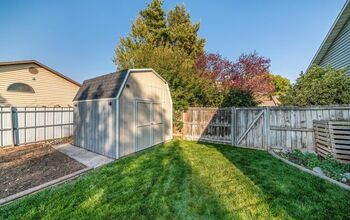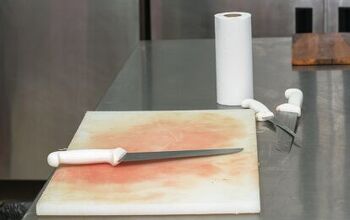Are Cutting Boards Heat Resistant?

Cutting boards are a standard tool in kitchens, providing a perfect surface for chopping, slicing, and dicing. For many home chefs, they also act as a place to put hot pots and pans to protect countertops. But cutting boards come in many sizes, styles, and materials, so which cutting boards are heat resistant?
Tempered glass, marble, and silicone cutting boards offer the most heat resistance, at least 480 degrees Fahrenheit. Bamboo and wood cutting boards can handle up to 350 to 400 degrees. Plastic cutting boards are also heat-resistant, but it’s best to wash them on the top rack of the dishwasher. Thin, cheap plastic cutting boards could melt under high heat.
Every type of cutting board has pros and cons, so make sure you know how you plan to use it. Once you’ve decided on the one you want, follow the manufacturer’s recommendations regarding heat. Various cutting board materials handle heat differently.
Are Wooden Cutting Boards Heat Resistant?
Wooden cutting boards are a popular choice of many chefs, thanks to their sturdiness, beauty, and durability. They also are a good match for sharp knives and won’t dull or chip your blades.
Wood cutting boards are also heat resistant up to about 350 degrees Fahrenheit. So, you can use them to place a hot pan or dish that doesn’t exceed this amount.
But, don’t expose your wooden cutting board to high heat for an extended period. Doing so could eventually damage your board. Therefore, if a dish is hotter than 350 degrees, let it cool some before transferring it to a wooden board.
Can A Wood Cutting Board Go In The Oven?
Some people will use a preheated oven to clean and sanitize a wooden cutting board. If you can guarantee the oven’s heat won’t top 350 degrees Fahrenheit, you can put a wooden cutting board in it. However, it’s not advisable, and you should avoid putting a wooden cutting board in the oven.
If the heat inside the oven gets too hot, your board could catch fire. Also, certain cleaners and oils used to maintain wooden boards can make them more susceptible to heat over time. Likewise, it’s best not to put a wooden cutting board in a microwave or a dishwasher.
How Much Heat Can Bamboo Handle?
A bamboo cutting board will usually handle up to 400 degrees Fahrenheit; some can go as high as 600 degrees. However, make sure the pot or pan you place on the board doesn’t exceed this temperature. Also, be mindful of how long you leave a hot pot on your bamboo cutting board.
It’s inadvisable to put bamboo cutting boards in an oven. Exposure to too much heat can soften the wood, compromising the board’s performance. Also, too much heat can dry out bamboo and wood cutting boards, leading to cracking and splitting over time.
Can I Put A Hot Food On A Plastic Cutting Board?
Durable, plastic cutting boards consisting of polypropylene offer some decent heat resistance. However, it’s best not to use them as hot plates for anything over 320 degrees Fahrenheit. It’s also not a good idea to put plastic cutting boards in the oven.
A good rule of thumb for plastic boards is to let pots and pans cool slightly before putting them on the plastic. For example, you might let your casserole dish rest on top of the stove for several minutes. Then, you can safely move it to the plastic board on your counter to free up space on your cooktop.
Also, placing thin, plastic chopping boards in the bottom of your dishwasher could melt the plastic. Therefore, wash all dishwasher-safe plastic cutting boards on the top rack.
What Are The Best Heat Resistant Cutting Boards?
Tempered glass cutting boards can withstand up to 470 degrees Fahrenheit, making them very heat resistant. These glass boards make an ideal trivet for food fresh out of the oven. They’re also a good match for easy cleaning in a hot dishwasher, making them a breeze to sanitize.
Marble and granite cutting boards are another excellent option for high heat resistance. Most marble boards can handle temperatures of 480 degrees Fahrenheit or higher. Some granite boards can tolerate even hotter temperatures, reaching 1,112 degrees Fahrenheit.
However, some people have claimed to experience discoloration over time from high heat and potential cracks. But cracking could be related to the quality or thickness of the cutting board as well.
It’s also worth remembering that even though you cook something at one temperature, it doesn’t mean the pan is at the same temperature. For example, what if you bake a pizza at 450 degrees on a metal pan? The pan itself could reach upward of 1,000 degrees when it’s straight out of the oven.
This sudden shock of high heat could lead to a potential crack. Therefore, always use common sense when placing hot dishes on your cutting boards.
Food-Grade Silicone Cutting Boards Resist Heat
High quality silicone cutting boards can withstand temperatures near 482 degrees Fahrenheit. Many silicone products can also go in the microwave, freezer, oven, and dishwasher. They’re also easy to clean and easy on knives, making them a popular choice.
Most Cutting Boards Can Handle Heat, But How Hot Varies
Most cutting boards are heat resistant, but depending on the material, each board offers different levels of resistance. Tempered glass, marble, granite, and silicone cutting boards provide some of the highest levels of heat resistance, starting around 480 degrees Fahrenheit.
Wooden cutting boards typically can handle around 350 degrees, while bamboo boards can withstand at least 400 degrees. Plastic boards offer the least heat resistance, with a melting point of 320 degrees Fahrenheit.
You can use a cutting board as a trivet for most hot dishes. But if your board is plastic, wood, or bamboo, it’s best to let the pan cool a bit before placing it on the cutting board.
Again, always consult the labeling that comes with your particular cutting board. Heat limits and usage can vary even among boards using the same materials. If your cutting board comes with a warranty, using it in a way that goes against the manufacturer’s recommendations can void the warranty.

Stacy Randall is a wife, mother, and freelance writer from NOLA that has always had a love for DIY projects, home organization, and making spaces beautiful. Together with her husband, she has been spending the last several years lovingly renovating her grandparent's former home, making it their own and learning a lot about life along the way.
More by Stacy Randall











![The 5 Best Angle Grinders – [2022 Reviews & Buyer's Guide]](https://cdn-fastly.upgradedhome.com/media/2023/07/31/9071326/the-5-best-angle-grinders-2022-reviews-buyer-s-guide.jpg?size=350x220)




![12 Washing Machine Brands to Avoid [with Recall Data]](https://cdn-fastly.upgradedhome.com/media/2023/07/31/9075781/12-washing-machine-brands-to-avoid-with-recall-data.jpg?size=350x220)










